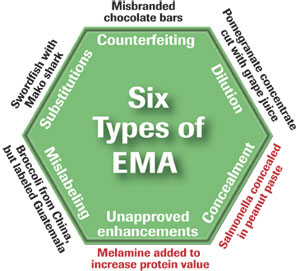Is your burger really 100 percent beef? Is your virgin olive oil really virgin? Only your analytical instrumentation knows for sure.
As a result of the recent UK horsemeat scandal, consumers and processors are very much aware they may not be getting what they paid for.
A well-attended conference session at BNP Media’s 2013 Food Safety Summit, Food Fraud/Economically Motivated Adulteration, brought counterfeit food issues

|
|
| Not all types of EMA are injurious to human health. The basic motive is to make as much money as possible, while operating secretly as long as possible. But some problems are bound to crop up, such as melamine in pet food and baby formula and Salmonella in peanut paste. |
to the forefront. John Spink, director of the food fraud initiative at Michigan State University (MSU) warned the audience that “counterfeiters attend anti-counterfeit conferences.” What better place for bad guys to learn how to manipulate the system?
Neil Stiber, FDA director, risk management staff, began the session with defining economically motivated adulteration (EMA) as the fraudulent, intentional substitution or addition of a substance in a product for the purpose of increasing the apparent value of the product or reducing the cost of its production, i.e., for economic gain.
EMA includes dilution of products with increased quantities of an already present substance (e.g., increasing inactive ingredients of a drug) to the extent such a drug-related dilution poses a known or possible health risk to consumers. EMA also includes the addition or substitution of substances to mask dilution.
EMA, according Stiber, costs the global food and consumer products industry $10 to $15 billion per year. One incident can cost a company 2-15 percent of its yearly revenues.
Spink suggests there are plenty of aspects of EMA/food fraud to worry about that could result in recalls. Since the purpose of EMA is to make money, the “bad guys” aren’t necessarily trying to make people sick, says Spink. In fact, they just want to keep operating in the background and making money, hoping they won’t get caught or cause a recall. Spink points to the recent horsemeat scandal and a few others that have been in the news:
• Peanut Corporation of America selling known contaminated product
• Pure olive oil diluted with other oils
• Melamine in pet food and infant formula
• Over-icing product with unsanitary water
• Unauthorized, unsanitary repackaging (up-labeling or origin laundering).
Fortunately, government and industry groups are addressing EMA problems, and there is help for processors that would like to get involved in combating food fraud. Jason Bashura, senior defense analyst for FDA’s Food Defense and Emergency Coordination Staff, described FDA’s interactions with the National Center for Food Protection and Defense (NCFPD, www.ncfpd.umn.edu). The goals of this joint effort are to identify foods at elevated risk of EMA; identify ingredients that are most susceptible to EMA so insufficient analytical methodologies can be addressed; conduct ongoing surveillance of various data sources that provide prior indication of EMA potential; and approach prevention and mitigation as needed specifically for each potential food or ingredient.
NCFPD has compiled documented incidents of EMA since 1980 into an online, searchable database hosted on www.foodshield.org. Food scientists from around the globe evaluated the monographs in the US Pharmacopeial Food Chemicals Codex for susceptibility to EMA. The results of these evaluations can be found at foodshield.org. In addition, NCFPD has developed a methodology for monitoring food imports for anomalies that could signal an increased risk for EMA. Finally, NCFPD is developing case studies for EMA-prone products to evaluate various data sources for scanning and understanding anomalies in food supply chains.



